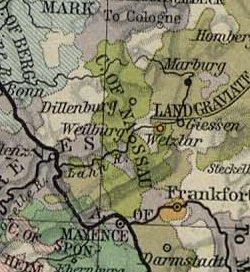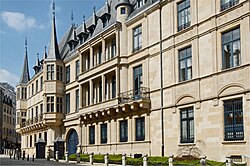Origins
Nassau, originally a county, developed on the lower Lahn river in what is known today as Rhineland-Palatinate. The town of Nassau was founded in 915. [1] Dudo of Laurenburg held Nassau as a fiefdom as granted by the Bishopric of Worms. His son, Rupert, built the Nassau Castle there around 1125, declaring himself "Count of Nassau". This title was not officially acknowledged by the Bishop of Worms until 1159 under the rule of Rupert's son, Walram. By 1159, the County of Nassau effectively claimed rights of taxation, toll collection, and justice, at which point it can be considered to become a state. [1]
The Nassauers held the territory between the Taunus and the Westerwald at the lower and middle Lahn. By 1128, they acquired the bailiwick of the Bishopric of Worms, which had numerous rights in the area, and thus created a link between their heritage at the lower Lahn and their possessions near Siegen. In the middle of the 12th century, this relationship was strengthened by the acquisition of parts of the Hesse-Thüringen feudal kingdom, namely the Herborner Mark, the Kalenberger Zent and the Court of Heimau (Löhnberg). Closely linked to this was the "Lordship of Westerwald", also in Nassau's possession at the time. At the end of the 12th century, the House acquired the Reichshof Wiesbaden, an important base in the southwest.
In 1255, after the Counts of Nassau acquired the estates of Weilburg, the sons of Count Henry II divided Nassau for the first time. Walram II received the county of Nassau-Weilburg. From 1328 on, his younger brother, Otto I, held the estates north of the Lahn river, namely the County of Nassau-Siegen and Nassau-Dillenburg. The boundary line was essentially the Lahn, with Otto receiving the northern part of the county with the cities of Siegen, Dillenburg, Herborn and Haiger and Walram retaining the section south of the river, including the cities of Weilburg and Idstein.
County of Nassau-Weilburg
Walram's son Adolf became King of Germany in 1292. His son Count Gerlach abdicated in 1344 and the county was divided under his sons in 1355
- County of Nassau-Weilburg, again divided from 1442 to 1574
- County of Nassau-Wiesbaden, again divided from 1480 to 1509
- County of Nassau-Idstein
- County of Nassau-Wiesbaden
fell back to Nassau-Weilburg in 1605
- County of Nassau-Sonnenberg, partitioned among Nassau-Wiesbaden and Nassau-Weilburg in 1405
In 1605, all parts of Nassau-Weilburg were again unified under Count Louis II; however, after his death in 1627, his sons divided the county again
- County of Nassau-Idstein, fell to Nassau-Ottweiler in 1721
- County of Nassau-Saarbrücken (Younger), divided again in 1640
- County of Nassau-Saarbrücken, fell to Nassau-Ottweiler in 1723
- County of Nassau-Ottweiler, fell to Nassau-Usingen in 1728
- County of Nassau-Usingen, Principality in 1688
- County of Nassau-Weilburg (Younger)
After Nassau-Usingen had inherited Nassau-Ottweiler with former Nassau-Idstein and Nassau-Saarbrücken, it was reunified with Nassau-Weilburg and raised to the Duchy of Nassau in 1806.
County of Nassau-Dillenburg
After the death of Count Otto I, his county was divided between his sons in 1303:
- County of Nassau-Dillenburg, fell to Nassau-Siegen in 1328
- County of Nassau-Hadamar (Elder), fell to Nassau-Dillenburg in 1394
- County of Nassau-Siegen, called Nassau-Dillenburg from 1328 on, again got divided from 1341 to 1561:
- County of Nassau-Beilstein (Elder)
- County of Nassau-Dillenburg (Elder)–1606)
In 1504, Henry III of Nassau-Dillenburg inherited the county's estates at Breda in the Duchy of Brabant, while his younger brother William became Count of Nassau-Dillenburg in 1516. After the son of Henry III, René of Châlon died in 1544, Count William's eldest son William the Silent became Prince of Orange and Lord of Breda, Stadtholder in the Low Countries from 1559 on. His younger brother, John VI, again reunited all Nassau-Dillenburg possessions in 1561, though the county was again divided after his death in 1606.
- County of Nassau-Hadamar (Younger), Principality in 1650, fell to Nassau-Diez in 1743
- County of Nassau-Siegen, (1607–23), again got divided from 1623 to 1734:
- County of Nassau-Siegen (Protestant), Principality in 1664, became extinct in 1734
- County of Nassau-Siegen (Catholic), Principality, fell to Nassau-Diez in 1743
- County of Nassau-Dillenburg, fell to Nassau-Beilstein in 1620
- County of Nassau-Beilstein (Younger), called Nassau-Dillenburg (Younger) from 1620 on, Principality in 1652, fell to Nassau-Dietz in 1739
- County of Nassau-Dietz, fell to Joachim Murat's Grand Duchy of Berg after the dissolution of the Holy Roman Empire in 1806
The Counts of Nassau-Dietz, descendants of William Frederick were stadtholders of Friesland, Groningen and Drenthe and Princes of Orange from 1702 on. When they lost their Dutch possessions during the Napoleonic Wars, they were compensated with the Principality of Nassau-Orange-Fulda. Though they lost their German possessions in 1806, the House of Orange-Nassau, through female succession, was the reigning house of the Grand Duchy of Luxembourg until 1890 and is still the royal house of the Netherlands.
This page is based on this
Wikipedia article Text is available under the
CC BY-SA 4.0 license; additional terms may apply.
Images, videos and audio are available under their respective licenses.












































































































